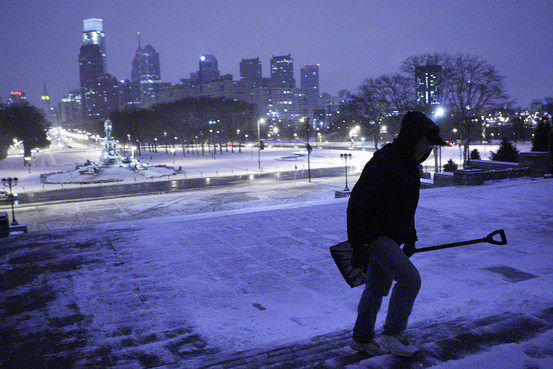 online.wsj.com/It’s safe to say we’ve received our fair share of snow this winter (with news of even more on the way!) The seemingly endless hours of snow removal can get frustrating, and for most the main goal is to travel safely to and from home without slipping on a slick patch of ice. However, try and remember the environment as you de-ice your walk way, or clear away snow.
online.wsj.com/It’s safe to say we’ve received our fair share of snow this winter (with news of even more on the way!) The seemingly endless hours of snow removal can get frustrating, and for most the main goal is to travel safely to and from home without slipping on a slick patch of ice. However, try and remember the environment as you de-ice your walk way, or clear away snow.
Here are some environmentally aware snow removal tips to get you started:
- Avoid the snow blower: Yes, using one of these may seem like the quickest solution, but these noisy polluters emit gasoline that could end up in streams and the soil.
- Avoid using salt to de-ice your sidewalk and driveway: It is corrosive to metal, harmful if it runs off into water ways, can corrupt soil structure, and is toxic to animals. Instead, try sand or wood ash from your fireplace. For an extensive explanation on the environmental affects of salt and other de-icers see this article on the “De-icing Dilemma.”
Continue after the jump for more tips.
- Something else to look into is EcoTraction (a traction agent manufactured from a hydrothermal volcanic mineral) which is safe for children, pets and wildlife if accidentally ingested. It may also be good for your lawn or garden, as the mineral improves soil aeration and water/nutrient retention.
- If you happen to have an abundance of de-icers from last year’s Snowpocalypse here are a few tips on using them safely and effectively from the PWD‘s Director of Planning & Research, Christopher Crockett:
-Shovel/sweep well after the snow has stopped and early in the day, so the sun can help melt the remaining snow.
-Put down sand or cat litter for traction.
-Use de-icers sparingly and at the recommended application rate, using a sprayer or spreader (don’t just go around with a bucket scooping it out all over the place).
-Don’t put de-icers on drains to unfreeze them, use a bucket of hot water instead.
-After application of de-icers during the day, wait a couple hours, if excess pellets or material is evident sweep it up and put in your trash/garbage.
-Re apply de-icer sparingly in stubborn spots that melt and re-freeze, and try to use sand and traction helpers instead.
- Use a good old-fashioned shovel: Especially good if this shovel is purchased from your local mom and pop shop. To avoid the back pain that often accompanies shoveling, look into purchasing a Sno Wovel. Basically, a snow shovel attached to a wheel that can clear away more snow with much less effort.






